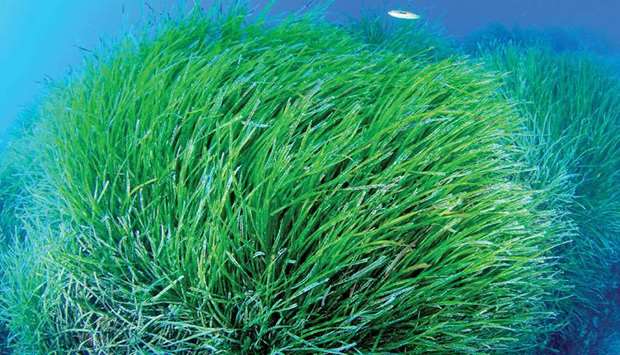Pere Palacio guides his dinghy carefully alongside the motor yacht in Es Calo bay in the north east of Mallorca and peers at a display unit that allows him to follow the path of the anchor.
“Is there a problem?” the boat owner asks him.
“No, everything’s good,” Palacio says, completing his examination.
On behalf of the local government in the Balearic Islands, Palacio checks that boats aren’t anchoring in Neptune grass, also known as posidonia oceanica, which is vital to the health of the Mediterranean Sea.
Neptune grass is a sort of underwater forest, Palacio explains. “It filters the water and makes sure it’s clear. It also provides a protective home for many creatures.” That includes several species of fish.
The inspector points to the shore, where clumps of the seagrass have formed small hillocks. At high tide, these weaken the force of the waves and make sure the beach remains intact, he says.
While many tourists get annoyed because they think it’s a kind of algae, “the Neptune grass actually ensures that the beach still exists.”
Posidonia oceanica only grows in the Mediterranean and is one of the most common seagrasses in the region – it grows from Croatia to Cyprus, from Egypt to Tunisia, from Sardinia to Spain.
On the IUCN Red List of Threatened Species, Neptune grass is only on the lowest rung of “last concern” – but the list still notes that it’s decreasing.
“In the past 50 years, stocks have gone down by 34 per cent,” says Maria del Mar Otero, a marine biologist who works for the IUCN’s Mediterranean programme.
The dangers to seagrass depend very much on the region, says Otero. Anchors, sewage and fishing, as well as the construction of harbour facilities, all threaten the plants.
The introduction of foreign species of algae in the Mediterranean has also been a problem.
“You can’t say as a general rule that the seagrass in one region is more threatened than in another,” says Otero. More is known about the northern Mediterranean, but there are also now projects in the southern parts of the sea.
Climate change is also increasingly affecting seagrass meadows.
“The Mediterranean is warming very fast,” says Otero. The consequences are still unpredictable, but they’re likely to affect the growth of plants and their prevalence.
In order to protect their growth, the Balearic region issued a decree this year, placing 650 square kilometres of seagrass meadows under increased protection.
“Of course there were measures in place beforehand, but none that were so specifically targeted at the situation in the Balearic Islands,” says Miguel Mir, general director of environmental protection at the local Environment Ministry.
Tackling illegal anchoring was already a priority before the decree was issued, as the heavy anchors rip up seagrass in huge clumps when they depart.
Five boats like that of Palacio patrol the seas every day in Mallorca. They carried out more than 17,000 checks on boats and yachts between May and the end of August and boats were told to move on around 2,800 occasions.
On Mallorca, authorities are not just trying to stop the destruction of Neptune grass. Scientists are also trying to plant it.
“In 2015 we began with a pilot project in the bay of Santa Ponca,” says Jorge Terrados, who works for the Imedea environmental institute and is responsible for planting the grass.
“Around 50 per cent of the plants survived, and we were very happy with that.”
The project was paid for by electricity grid operator Red Electrica, which had laid cables through the sea grass and wanted to make amends for some of the damage.
When the results proved hopeful, Red Electrica and Imedea agreed to a bigger project in the bay of Pollenca in the north of the island.
A seagrass meadow covering an area of 50 by 50 metres has been planted since the beginning of the year. Divers look for plants that have been ripped up by the sea, but are still intact.
“We replant these in groups five metres apart,” says Terrados.
Patience is necessary. “Posidonia oceanica breaks very easily and only grows back slowly – around one to three centimetres per year,” he says.
He hopes that one day the area will be completely covered by sea grass. “But that could take decades – even centuries.” – DPA

PROTECTION: Neptune grass, also known as posidonia oceanica, functions as a sort of underwater forest, providing a protective home for many creatures.

